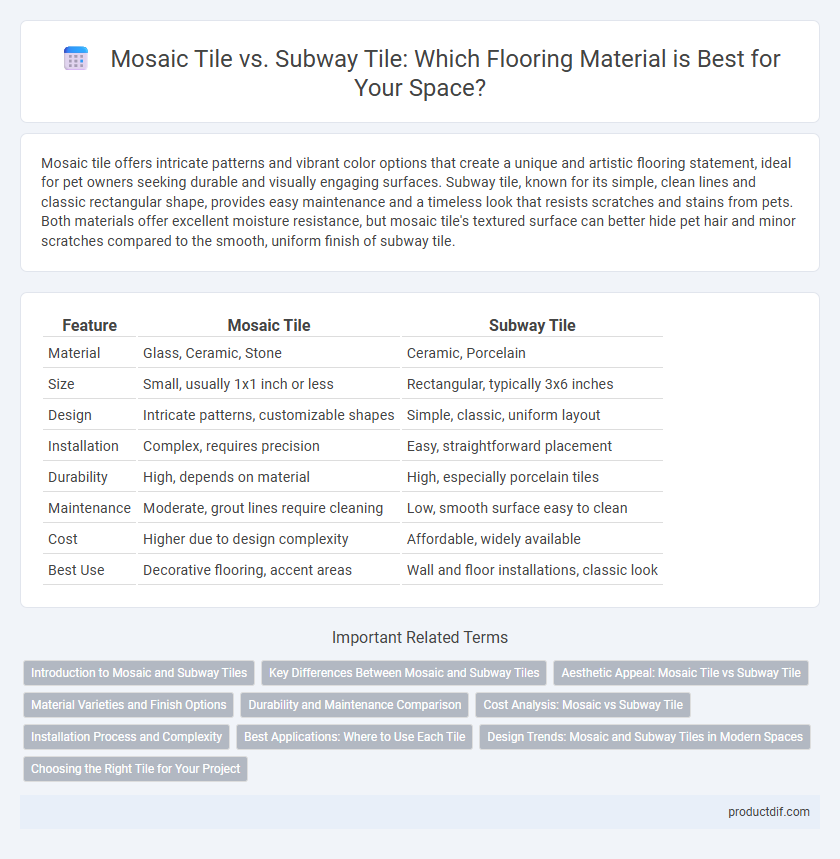Mosaic tile offers intricate patterns and vibrant color options that create a unique and artistic flooring statement, ideal for pet owners seeking durable and visually engaging surfaces. Subway tile, known for its simple, clean lines and classic rectangular shape, provides easy maintenance and a timeless look that resists scratches and stains from pets. Both materials offer excellent moisture resistance, but mosaic tile's textured surface can better hide pet hair and minor scratches compared to the smooth, uniform finish of subway tile.
Table of Comparison
| Feature | Mosaic Tile | Subway Tile |
|---|---|---|
| Material | Glass, Ceramic, Stone | Ceramic, Porcelain |
| Size | Small, usually 1x1 inch or less | Rectangular, typically 3x6 inches |
| Design | Intricate patterns, customizable shapes | Simple, classic, uniform layout |
| Installation | Complex, requires precision | Easy, straightforward placement |
| Durability | High, depends on material | High, especially porcelain tiles |
| Maintenance | Moderate, grout lines require cleaning | Low, smooth surface easy to clean |
| Cost | Higher due to design complexity | Affordable, widely available |
| Best Use | Decorative flooring, accent areas | Wall and floor installations, classic look |
Introduction to Mosaic and Subway Tiles
Mosaic tiles consist of small pieces of glass, ceramic, or natural stone arranged to create intricate patterns and detailed designs, offering versatility for both walls and floors. Subway tiles are rectangular, typically measuring 3x6 inches, known for their classic brick-like layout and smooth, glossy finish commonly used in kitchens and bathrooms. Both types provide durable, easy-to-clean surfaces but vary significantly in aesthetic appeal and installation complexity.
Key Differences Between Mosaic and Subway Tiles
Mosaic tiles consist of small, intricately arranged pieces often made from glass, ceramic, or stone, creating complex patterns and vibrant color variations, ideal for decorative accents or backsplashes. Subway tiles are larger, rectangular ceramic or porcelain tiles traditionally used in a brick-like offset pattern, offering a clean, uniform look suitable for walls and floors in modern or classic designs. Key differences include size, design versatility, installation complexity, and typical applications, with mosaics providing more artistic detail and subways delivering simplicity and ease of maintenance.
Aesthetic Appeal: Mosaic Tile vs Subway Tile
Mosaic tile offers intricate patterns and vibrant color combinations that create a visually dynamic and artistic flooring surface. Subway tile provides a clean, classic look with uniform rectangular shapes, ideal for minimalist or traditional designs. Choosing between mosaic and subway tiles depends on the desired aesthetic impact, where mosaic tiles bring decorative complexity and subway tiles deliver timeless simplicity.
Material Varieties and Finish Options
Mosaic tiles offer a diverse range of material varieties including glass, ceramic, marble, and porcelain, providing intricate patterns and vibrant color options ideal for decorative accents. Subway tiles, traditionally made from ceramic or porcelain, emphasize clean lines and uniformity with finish options like glossy, matte, or textured surfaces for a classic, timeless look. Both tile types offer versatile finishes to suit various design aesthetics, but mosaic tiles excel in customizable shapes and color combinations.
Durability and Maintenance Comparison
Mosaic tiles, made from durable materials like glass, ceramic, and natural stone, offer high resistance to wear and moisture, making them suitable for areas with frequent water exposure. Subway tiles, typically ceramic or porcelain, provide excellent durability and a smooth, non-porous surface that resists stains and is easy to clean. Maintenance for mosaic tiles may require more frequent grout sealing due to numerous grout lines, while subway tiles generally need less upkeep and quicker cleaning routines.
Cost Analysis: Mosaic vs Subway Tile
Mosaic tiles typically cost between $7 to $20 per square foot due to their intricate patterns and smaller sizes, while subway tiles range from $2 to $5 per square foot, making them a more budget-friendly option for flooring. Installation costs for mosaic tiles are generally higher because they require precise placement and more labor time, often increasing total expenses by 15% to 30% compared to subway tiles. When considering cost efficiency, subway tiles offer a more affordable solution for larger flooring projects without sacrificing durability and style.
Installation Process and Complexity
Mosaic tile installation requires meticulous attention to detail due to its small, intricate pieces that often come on mesh sheets, demanding precise alignment and repetitive grouting. Subway tile installation is generally more straightforward, with larger tiles arranged in simple, staggered rows, reducing complexity and installation time. Both materials benefit from proper surface preparation, but mosaic tiles typically need more specialized tools and skills to ensure durability and aesthetic appeal.
Best Applications: Where to Use Each Tile
Mosaic tiles excel in creating intricate, decorative patterns ideal for backsplashes, shower floors, and accent walls, offering slip resistance and design flexibility in smaller areas. Subway tiles are best suited for larger surfaces like kitchen backsplashes and bathroom walls, providing a classic, clean look with easy maintenance and installation. Choosing mosaic tile enhances visual interest in confined spaces, while subway tile offers a timeless, versatile option for broad, uniform coverage.
Design Trends: Mosaic and Subway Tiles in Modern Spaces
Mosaic tiles offer intricate patterns and vibrant color combinations, making them ideal for accent walls and decorative flooring in contemporary interiors. Subway tiles, known for their clean, rectangular shape and classic layout, provide a timeless, minimalist aesthetic that enhances kitchens and bathrooms. Both materials remain popular in modern design, with mosaic tiles adding artistic flair and subway tiles delivering sleek simplicity.
Choosing the Right Tile for Your Project
Mosaic tile offers intricate patterns and vibrant colors ideal for decorative accents and small spaces, while subway tile provides a classic, timeless look with clean lines perfect for larger wall areas and straightforward designs. Consider the project's scale, desired aesthetic, and maintenance requirements when selecting between mosaic and subway tile to ensure durability and style coherence. Evaluating factors like slip resistance, grout size, and installation complexity helps achieve the best flooring outcome tailored to residential or commercial needs.
Mosaic Tile vs Subway Tile Infographic

 productdif.com
productdif.com